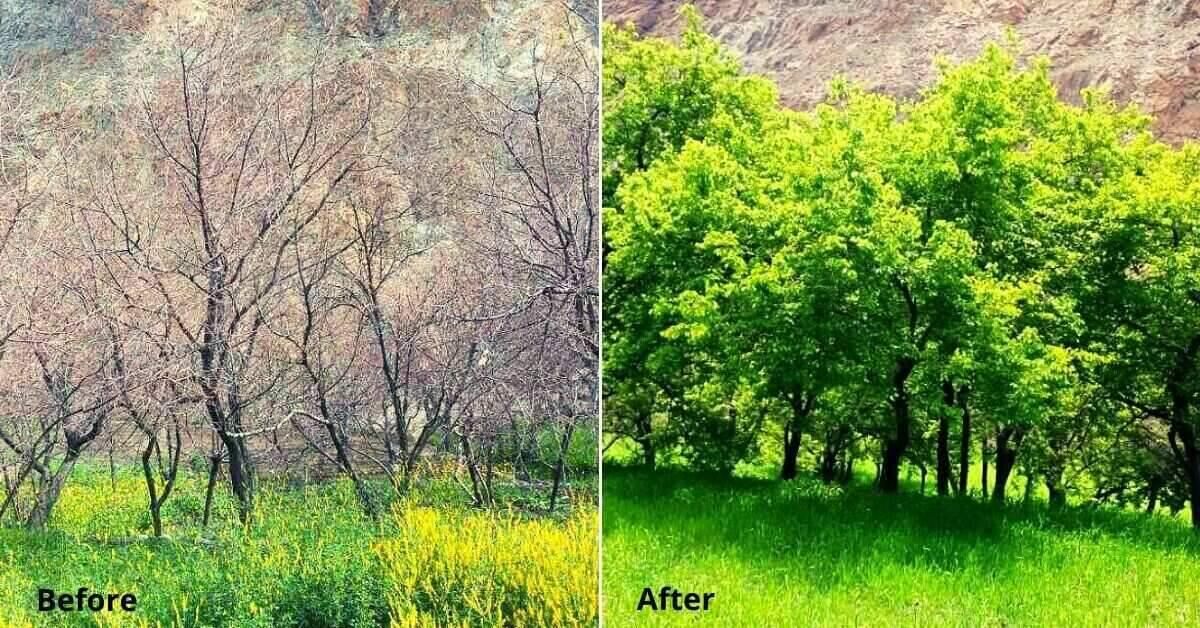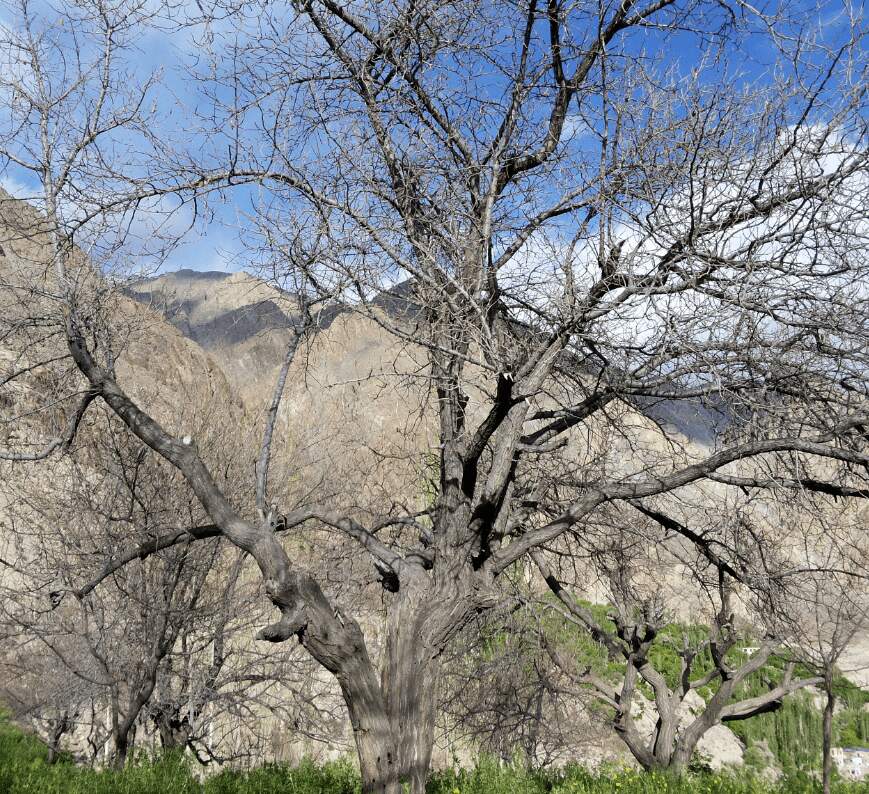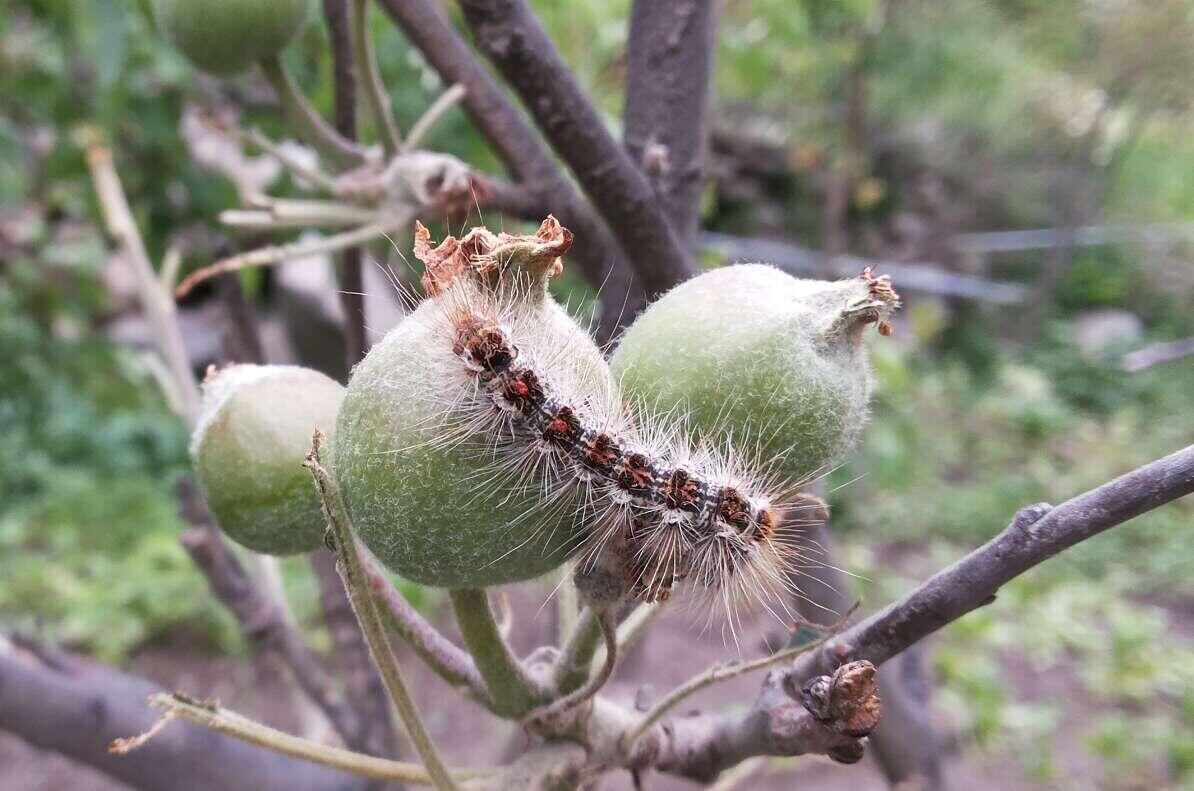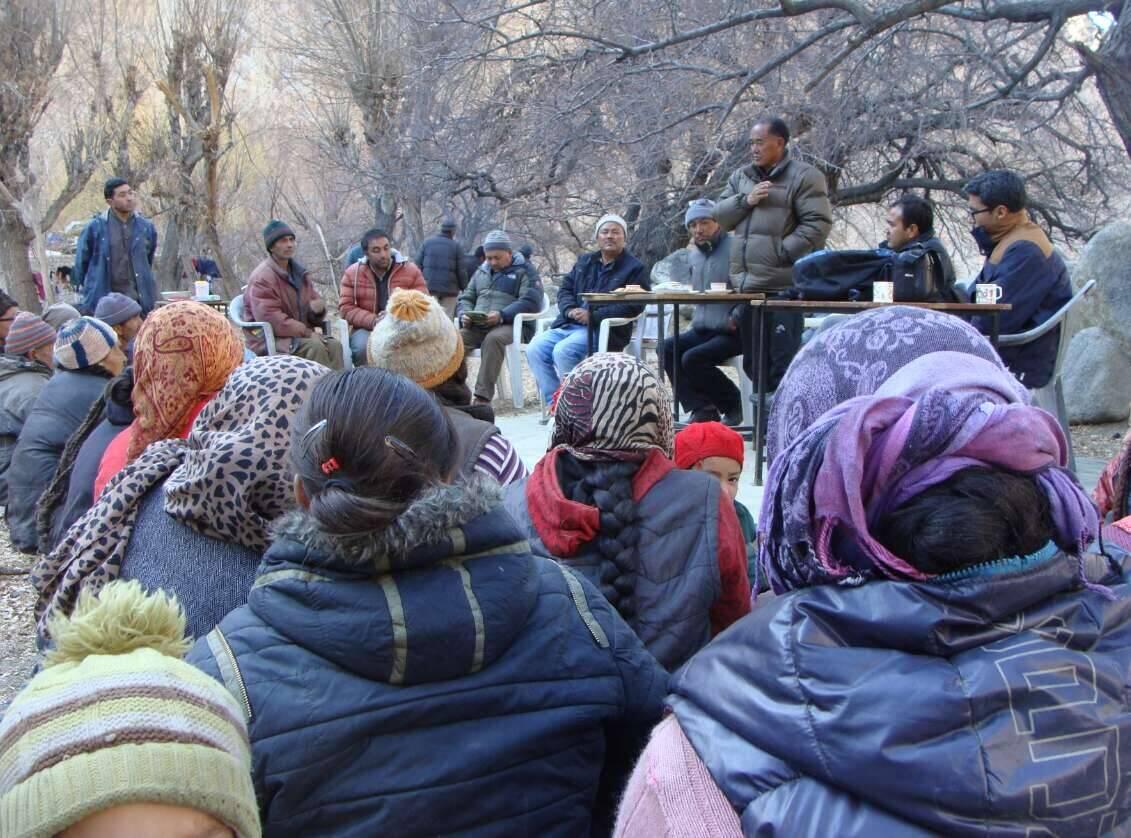After Moths Ruined Apricots Worth Rs 2.3 Cr, Ladakhis Saved The Trees in Just 2 Years
The incredible story of how a team of scientists, government officials, village heads, NGOs and apricot farmers came together and eradicated the yellow-tail moth pest completely in barely two years.

Nearly 62 per cent of India’s apricots are produced in the cold desert of Ladakh, according to a recent report issued by the Ladakh Autonomous Hill Development Council (LAHDC), Leh.
With annual production standing at 15,671 MT (Leh: 5,105, Kargil: 10,656), this fruit crop is a significant livelihood source and intertwined with the region’s culture and traditions.
At the centre of apricot production in Leh district lies the picturesque valley of Dah-Hanu, which is home to the indigenous Brokpa community. But between 2013 and 2016, farmers of Dah, Hanu Thang and Biama (villages in the Dah-Hanu Valley) lost 80 per cent of their apricot crop because of a yellow-tail moth (Euproctis similis) pest infestation, which was last seen about 50 years ago, according to village elders. In 2015, the pest also spread to the adjoining villages of Achinathang, Skurbuchan and Takmachik (in Sham Valley) in the following year.
Overall, farmers in these five villages lost Rs 2.32 crore income in just 2016 from the damage caused to their apricot crop. Villagers perceived the severe infestation as a result of climate change and disrespect of local deities. If appropriate control measures were not taken, the pest could destabilize the entire apricot industry of the region.
“This pest problem came to the notice of our institute and the local administration only in 2016 even though it had begun to spread three years ago. We had no idea about the very existence of this pest before 2016. Only when we began investigating the problem and prepared a report did we realise that this pest problem had been going on since 2013. Until the situation got terrible, residents of these villages never complained to us about it. As an agricultural scientist working in Ladakh for many years, I had never seen such a devastating pest infestation in my life. When we looked into the scientific literature, we realised that there is no report of this insect-pest in the country. Besides, this insect is not known to be a major pest of fruit trees,” says Dr Tsering Stobdan, a leading scientist at the Defence Institute of High Altitude Research (DIHAR), speaking to The Better India.
By 2019, however, a team of scientists led by Dr Stobdan, government officials, village heads, NGOs and the main stakeholders, farmers, had come together and eradicated the pest.
Since 2019, there have been no reports of this particular pest.
Understanding the Yellow-Tail Moth
Apricots in Ladakh ripe in late July to early September. The yellow-tail moth’s larvae (caterpillars) emerge in early May after overwintering and voraciously feed on the apricot crop, causing complete defoliation of trees from May to June.
Their impact is so devastating that from a distance, it appears like entire apricot trees have been burnt down, leaving behind only the unripe infested fruits. The leaves emerge again after July when the caterpillar goes into pupation and enters its adult stage.
“Our elders remember having seen a similar infestation once in Gurgur-Do village of Dah-Hanu valley more than 50 years ago,” says Lamchung Serkyang, a farmer from Biama village. In addition, the hairs of the caterpillar cause allergic reactions like skin rashes and respiratory problems.
“In spring, as soon as the earliest leaf buds open, the larvae (caterpillars) become active and crawl out of their webs to feed on the tender new leaves. In late June, the larvae spin cocoons in which it pupates. Pupal cocoons are full of toxic hairs and should be removed with great caution. The pupae develop into a moth that emerges from their cocoons in July. After emerging, the females lay eggs in masses. Each female is known to lay 200 to 400 eggs. During August or early in September, the eggs hatch and young larvae (caterpillars) feed for a short time on the leaves before building their winter webs. However, the autumn feeding inflicts less damage to the trees,” says the LAHDC report authored by a team of four agricultural scientists and an officer of the horticulture department led by Dr Stobdan.
Besides him, the team included Dr Mohammed Deen of Ladakh Environment and Health Organisation (LEHO), Dr Vikas Gupta of the Sher-e-Kashmir University of Agricultural Sciences (SKUAST-K), Dr MS Raghuvanshi of ICAR-Central Arid Zone Research Institute (CAZRI), Jodhpur and Tsewang Phunchok, Chief Horticultural Officer, Leh.
According to the LAHDC report, the extent of damage to apricot trees in each village ranged from 15 to 90 per cent. The annual income from the sale of dried and fresh apricot without pest infestation was Rs 3.44 crore. The economic loss due to defoliating caterpillars in the affected five villages was Rs 2.32 crore in 2016. The maximum economic impact was felt in Dah, Hanu Thang and Biama.
Integrated Management of Yellow-Tail Moth
Given the devastation, in October 2016, the LAHDC constituted a committee of agricultural scientists led by Dr Stobdan to assess the problem and suggest management strategies. Within 10 days, they submitted a report to the Council.
The committee issued two key recommendations:
1) Involve all government departments working on agriculture-related issues, research institutes, village heads, the local community and the NGOs working in the district. Only a combined effort would address this problem in a time-bound manner.
2) Adopt an Integrated Pest Management (IPM) approach: According to the United States Department of Agriculture (USDA), an IPM approach involves a “science-based, decision-making process that identifies and reduces risks from pests and pest management related strategies.” But who would implement IPM in these five villages?
The Horticulture Department and DIHAR would oversee efforts in Dha and Biama. Efforts in Skurbuchan would be overseen by SKUAST-K and Tata Trust, while Achinathang and Takmachik were allocated to LEHO. Similar efforts are also being organised to address other pests like aphids in different villages across the district.
So, how does IPM translate in these villages?
1) Raising Awareness: This is probably the most crucial step. The general assumption amongst farmers was that the evolution of the pest from larvae (caterpillar) to adult moth was the end of pest infestation since the leaves emerge again.
“We needed to build awareness among the farmers about the pest’s complete life cycle. It was hard for farmers to believe that the caterpillar completely changed its form and turned into a moth. Considering the damage it caused from 2013 to 2016; we spent the first three to four months of 2017 spreading awareness about the pest’s complete lifecycle and what management strategies needed to be adopted. We also needed to create awareness about the importance of how to use chemical insecticides in a limited manner by training local youths at our own orchards in DIHAR,” says Dr Stobdan.
2) Community Engagement: Another critical step in the process is convincing local elected representatives and village heads about the need to involve each household in pest management. Discussions were held at the village level between elected representatives (Councillors), village heads and the scientific community.
“For initiatives like these, we have to mobilise the entire community. Otherwise, there is no way we can manage this pest infestation. In this regard, the role of politicians has been very impactful because they are good at mobilising people and bringing them together. To get this initiative underway, we needed quick decisions from the entire community, and the politicians helped facilitate that for us,” says Tsering, ex-sarpanch of Dah village.
In fact, the then Ladakh’s Member of Parliament, Thupstan Chewang, sanctioned Rs 25 lakh from the MP Local Area Development Scheme to facilitate this initiative.
3) Orchard Sanitation from November to March: Here’s where we come to the meat of the matter. The most effective and economical way to avoid many pest problems is to create an environment that discourages pests or reduces the tree’s susceptibility to damage.
It’s fundamental to understand that pests overwinter and survive on tree parts and debris. What farmers did was gather and destroy the fallen fruits and fruits remaining on trees after harvest and remove dead leaves from trees by shaking/bearing with a stick, preferably after mid-November.
“You then collect/rake fallen leaves from the orchard floor and put them either in a compost pit or over an active compost pile. What follows is pruning and destroying the dead and injured twigs and branches, and finally removing the pile of wood and other debris where insect larvae may find shelter during the winter,” says Dr Stobdan.
4) Clipping and destroying overwintering webs: A key reason why pests can overwinter as larvae (caterpillars) in colonies is that they are enclosed within webbed nests of white silk, which is tightly woven on trees or shrubs.
According to the LAHDC report, the webs (nests) are spun in early autumn, contain anywhere between 25 and 400 larvae and remain firmly attached to twigs or small branches through the winter into early spring. These webs are most commonly found on twig ends and are clipped and destroyed by burning or deep burial.
5) Pruning: This step involves cutting or removing stems and branches that were dead, broken, diseased or overcrowded. Farmers were advised to take this step in late spring (March and April) when the trees were still dormant and not in summer or after early August.
6) Chemical Control of feeding larvae through broad-spectrum insecticide:
This happens in three stages. The first round of low concentration chemical pesticide is sprayed 15 days before flowering in April. Going further, the next round is sprayed in May after the petal fall stage. The final round of pesticide is sprayed in late May depending on the needs 15 to 20 days after the second spray.
Thankfully, there was no report of pesticide poisoning from any of the affected villages.
However, Dr Stobdan and his team have also suggested non-chemical control measures, which are being implemented in villages like Takmachik, where farmers practise organic farming, although the yellow moth pest infestation wasn’t as severe there.
“The most common organic method of control of the defoliating caterpillar is the application of Bt bacteria. Bacillus thuringiensis var. kurstaki (Btk) is a bacterium that releases a protein called ‘endotoxin’ that poisons the insect digestive system. To work, it must be digested by the caterpillar,” states the LAHDC report.
Another way of non-chemical pesticide pest control is to set up ‘Pheromone traps’. “Pheromones are chemicals that insects use to communicate with one another. The pheromones used in these traps are synthesized female sex pheromone and attract males. The males get stuck on the trap’s sticky surface, letting us know when they are active. The traps help determine the proper time to apply control sprays,” the report adds.
But it’s not a very effective mode of pest control because only the male insect gets caught. When used in large amounts, pheromones can control some pests in large orchards. These pheromones, enclosed in dispensing devices, are placed in fruit trees throughout the orchard. Their power lies in ensuring males don’t find their female partners for mating, thus unable to lay eggs. Finally, there are generic sticky traps measuring 6 to 8 feet high and placed 1 to 3 feet “inside the canopy in the north quadrant of the tree, in the shade, and at least five trees in from the edge of the orchard,” says the report.
This is What Success Looks Like
In the first year of this IMP initiative in 2017, only 18.8 per cent of trees were found heavily infested compared to 63.8 per cent the year before. This number dropped to 5.5 per cent in the second year, and finally, in 2019, none of the trees was found infested.
Meanwhile, fruit yield increased to 66.3 per cent (from pre-pest attack levels) in 2017 compared to 38.8 per cent the year before. In 2018 and 2019, the yield achieved was 85 per cent and 95.8 per cent, respectively, compared to a normal season without the pest attack. Meanwhile, the number of allergic reactions resulting from skin contact with hair-like seta found on caterpillars dropped from 222 cases in these five villages in 2016 to no cases in 2018. Since 2019, no incidence of this particular pest attack has been reported.
“There were concerns that farmers would not use chemical insecticides to kill insect-pests because it may fall afoul of their religious sentiments with a predominantly Buddhist population. However, if properly educated, they are ready to control insect-pests. During the awareness runs in these villages, we explained to them that if we do not control its spread in a season or two, it will cause serious problems moving forward. This initiative underscored the importance of community-level management to control pest outbreaks. After all, no one could do this on their own,” says Dr Stobdan.
(Edited by Vinayak Hegde)
Like this story? Or have something to share? Write to us: [email protected], or connect with us on Facebook and Twitter.
This story made me
- 97
- 121
- 89
- 167
Tell Us More
We bring stories straight from the heart of India, to inspire millions and create a wave of impact. Our positive movement is growing bigger everyday, and we would love for you to join it.
Please contribute whatever you can, every little penny helps our team in bringing you more stories that support dreams and spread hope.



















